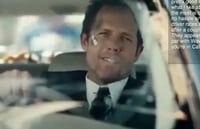Brand as Star? Supporting Actor? Director? Producer?
By John Kastenholz and Chuck Young
Aspiring to play a specific role in the customer’s mind is, or should be, a focus for brands. But, in the context of marketing, what role should they play? That of the hero or, as many marketing experts believe, that of the mentor.
Brands can, and should, play different roles depending on lifestage, story and current consumer perceptions of those brands. There’s another set of metaphors for understanding successful brand roles in ad stories. To do that, let’s borrow from a concept that we can all identify with: movies.
The four different roles of the brand:
Brand as Star
The most obvious role for the brand is that of the star. In this first type of drama, the plot is quite simple: negative dramatic tension is created in the beginning of the ad, then the brand arrives on its white horse and makes the negative feelings go away, so that the audience leaves with a happy ending. If the brand arrives at just the right moment in the story, then the brand receives credit for being perceived as the cause of this change or resolution of emotional tension—the brand has been cast as the star role in the film.

For example, one might argue that actor Dean Winters, portraying the hilarious character, “Mayhem,” is the star of Allstate’s ads. However, it is in fact, Mayhem who is the antagonist in these stories, making Allstate Insurance the Protagonist, or the hero. In fact, in Robert McKee’s, Story: Principles of Screenwriting, he writes, “A protagonist and his story can only be as intellectually fascinating and emotionally compelling as the forces of antagonism make them.”
Mayhem may be driving force for Allstate’s stardom in these stories, but as the villain for Allstate to defeat.
Brand as Supporting Actor
In this second type of story, the brand is not the star but plays the role of supporting actor. It is the Sancho Panza to the consumer’s Don Quixote. The customer, by projection, is given the starring role and the brand is given the role of “mentor.” The brand is part of the action and necessary to advance the scene and create twists in the plot.
The role of the high-performing car in some automotive advertising, for example, is to take ordinary life and elevate it to a higher plane of experience—which is in the end the promise the brand is making to the consumer as driver. Again, timing is a key point with this type of dramatic structure: the brand should arrive at the boundary between the low emotion state and the higher emotion state—so that the brand receives the credit as being perceived as the cause of the enhanced consumer experience.
One of the most memorable of these is depicted in The Force from Volkswagon where a pint-sized Darth Vader brings the story to life.
Brand as Director
In this third type of story, the brand is not an actor in the story but is acknowledged in the credits at the end of the film. The brand is the director, unseen but an always-present intelligence, building a story to give meaning or definition to the experience promised to the audience.
Though seeing black-and-white spots may cue Chic-fil-a for most by now, that wasn’t always the case. Using cows to sell chicken was a risky maneuver for a lesser-known fast food chicken chain when the campaign first debuted in 1995, and has been building on ever since.
However, part of the brilliance instilled into the TV advertising was the “reveal” structure used by The Richard’s Group. Letting the story unfold without use of words to reveal the brand at the end truly allows Chic-fil-a to take credit for such entertainment.
Brand as Producer
The fourth type—the thrilling exciting hilarious celebration of amazing sights and sounds you’ve never seen before—brought to you by—presented to you by—the brand!
It’s the brand as the producer of sustained emotions, the rock concert promoter of good vibes, the P.T. Barnum of emotional end benefits. And it is upfront about telling you so. No shyness here.
More recent Geico TV commercials and pre-roll ads follow this format, in fact, by only using the first 5 seconds to communicate the ad’s message. The remaining 25 seconds is purely in place to generate talk-value.
All four approaches to emotional advertising work well. Yet these four types represent a considerable repertoire for deploying emotions in the service of building brands. Importantly, advertising works in more than one way, particularly on an emotional level. What this means from a practical perspective is that creatives should be empowered to depict and attempt to evoke the full spectrum of human emotion from despondence to elation.
John Kastenholz is vice president, consumer insights, ConAgra Foods. He can be reached at [email protected]. Charles Young is CEO/founder, Ameritest. He can be reached at [email protected].






























